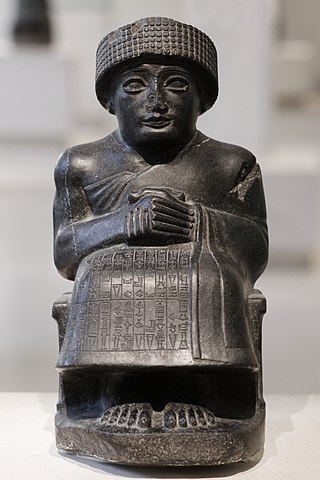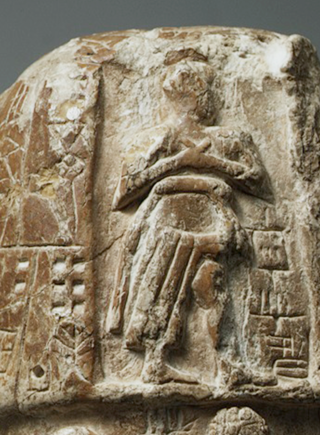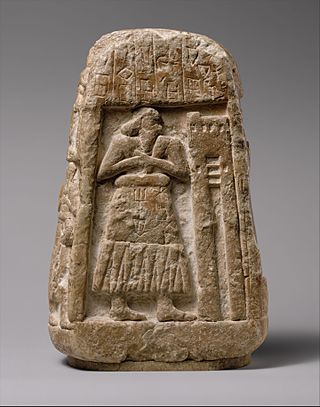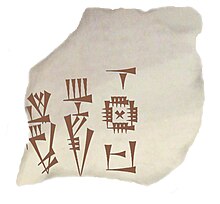
The Sumerian King List or Chronicle of the One Monarchy is an ancient literary composition written in Sumerian that was likely created and redacted to legitimize the claims to power of various city-states and kingdoms in southern Mesopotamia during the late third and early second millennium BC. It does so by repetitively listing Sumerian cities, the kings that ruled there, and the lengths of their reigns. Especially in the early part of the list, these reigns often span thousands of years. In the oldest known version, dated to the Ur III period but probably based on Akkadian source material, the SKL reflected a more linear transition of power from Kish, the first city to receive kingship, to Akkad. In later versions from the Old Babylonian period, the list consisted of a large number of cities between which kingship was transferred, reflecting a more cyclical view of how kingship came to a city, only to be inevitably replaced by the next. In its best-known and best-preserved version, as recorded on the Weld-Blundell Prism, the SKL begins with a number of fictional antediluvian kings, who ruled before a flood swept over the land, after which kingship went to Kish. It ends with a dynasty from Isin, which is well-known from other contemporary sources.

The history of Sumer spans through the 5th to 3rd millennia BCE in southern Mesopotamia, and is taken to include the prehistoric Ubaid and Uruk periods. Sumer was the region's earliest known civilization and ended with the downfall of the Third Dynasty of Ur around 2004 BCE. It was followed by a transitional period of Amorite states before the rise of Babylonia in the 18th century BCE.

Mesannepada (Sumerian: 𒈩𒀭𒉌𒅆𒊒𒁕, Mesannipàdda [MES-AN-NE2-PAD3-DA]), Mesh-Ane-pada or Mes-Anne-pada ("Youngling chosen by An"; fl. c. 2550 BC) was the first king listed for the First Dynasty of Ur (c. 26th century BC) on the Sumerian king list. He is listed to have ruled for 80 years, having overthrown Lugal-kitun of Uruk: "Then Unug (Uruk) was defeated and the kingship was taken to Urim (Ur)". In one of his seals, found in the Royal Cemetery at Ur, he is also described as king of Kish.

Shu-turul was the last king of the Akkadian Empire, ruling for 15 years according to the Sumerian king list. It indicates that he succeeded his father Dudu. A few artifacts, seal impressions etc. attest that he held sway over a greatly reduced Akkadian territory that included Kish, Tutub, Nippur, and Eshnunna. The Diyala river also bore the name "Shu-durul" at the time.
Adab was an ancient Sumerian city between Girsu and Nippur, lying about 35 kilometers southeast of the latter. It was located at the site of modern Bismaya or Bismya in the Al-Qādisiyyah Governorate of Iraq. The site was occupied at least as early as the 3rd Millenium BC, through the Early Dynastic, Akkadian Empire, and Ur III empire periods, into the Kassite period in the mid-2nd millennium BC. It is known that there were temples of Ninhursag/Digirmah, Iskur, Asgi, Inanna and Enki at Adab and that the city-god of Adab was Parag'ellilegarra (Panigingarra) "The Sovereign Appointed by Ellil".

The first dynasty of Ur was a dynasty of rulers from the city of Ur in ancient Sumer who reigned c. 2600 – c. 2340 BC. Ur I is part of the Early Dynastic III period of ancient Mesopotamia. It was preceded by the earlier First Dynasty of Kish and the First Dynasty of Uruk.

Lugal-Zage-Si of Umma was the last Sumerian king before the conquest of Sumer by Sargon of Akkad and the rise of the Akkadian Empire, and was considered as the only king of the third dynasty of Uruk, according to the Sumerian King List. Initially, as king of Umma, he led the final victory of Umma in the generation-long conflict with the city-state Lagash for the fertile plain of Gu-Edin. Following up on this success, he then united Sumer briefly as a single kingdom.
Kubaba was a legendary Mesopotamian queen who according to the Sumerian King List ruled over Kish for a hundred years before the rise of the dynasty of Akshak. It is typically assumed that she was not a historical figure.
Bad-tibira, "Wall of the Copper Worker(s)", or "Fortress of the Smiths", identified as modern Tell al-Madineh, between Ash Shatrah and Tell as-Senkereh and 33 kilometers northeast of ancient Girsu in southern Iraq, was an ancient Sumerian city on the Iturungal canal, which appears among antediluvian cities in the Sumerian King List. Its Akkadian name was Dûr-gurgurri. It was also called Παντιβίβλος (Pantibiblos) by Greek authors such as Berossus, transmitted by Abydenus and Apollodorus. This may reflect another version of the city's name, Patibira, "Canal of the Smiths".
Akshak was a city of ancient Sumer, situated on the northern boundary of Akkad, sometimes identified with Babylonian Upi. It is known, based on an inscription "‘Ur-kisala, the sangu-priest of Sin of Akshak, son of Na-ti, pasisu-priest of Sin to Salam presented [this statue]." that there was a temple of the god Sin in Akshak.

The Early Dynastic period is an archaeological culture in Mesopotamia that is generally dated to c. 2900 – c. 2350 BC and was preceded by the Uruk and Jemdet Nasr periods. It saw the development of writing and the formation of the first cities and states. The ED itself was characterized by the existence of multiple city-states: small states with a relatively simple structure that developed and solidified over time. This development ultimately led, directly after this period, to broad Mesopotamian unification under the rule of Sargon, the first monarch of the Akkadian Empire. Despite their political fragmentation, the ED city-states shared a relatively homogeneous material culture. Sumerian cities such as Uruk, Ur, Lagash, Umma, and Nippur located in Lower Mesopotamia were very powerful and influential. To the north and west stretched states centered on cities such as Kish, Mari, Nagar, and Ebla.

Dumuzid, titled the Fisherman, was a legendary Sumerian king of Uruk listed originating from Kuara. According to legend, in the one-hundredth year of his reign, he was captured by Enmebaragesi.

Aga commonly known as Aga of Kish, was the twenty-third and last king in the first dynasty of Kish during the Early Dynastic I period. He is listed in the Sumerian King List and many sources as the son of Enmebaragesi. The Kishite king ruled the city at its peak, probably reaching beyond the territory of Kish, including Umma and Zabala.
Tummal (Tum-ma-alki) was an ancient Near East cult site of the goddess Ninlil, as Egi-Tummal, currently unlocated but known to be in the vicinity of Nippur and Drehem. E-Tummal was the temple to Ninlil located there.

Meskiagnun, also Mesh-ki-ang-Nanna, was the fourth lugal or king of the First Dynasty of Ur, according to the Sumerian King List, which states he ruled for 36 years.

The Stele of Ushumgal is an early Sumerian stone tablet, dating to the Early Dynastic I-II, and probably originating from Umma. It is currently located in the Metropolitan Museum of Art, New York City.

Lugalshaengur, , was ensi (governor) of the Sumerian city-state of Lagash.

Lugal-kinishe-dudu also Lugal-kiginne-dudu , was a King and (ensi) of Uruk and Ur who lived towards the end of the 25th century BC. The Sumerian King List mentions Lugal-kinishe-dudu as the second king of the dynasty after En-shakansha-ana, attributing to him a fanciful reign of 120 years.

Nin-kisalsi was a Sumerian ruler of the Mesopotamian city of Adab in the mid-3rd millennium BCE, probably circa 2500 BCE.

Gilgamesh and Aga, sometimes referred to as incipit The envoys of Aga, is an Old Babylonian poem written in Sumerian. The only one of the five poems of Gilgamesh that has no mythological aspects, it has been the subject of discussion since its publication in 1935 and later translation in 1949.




























